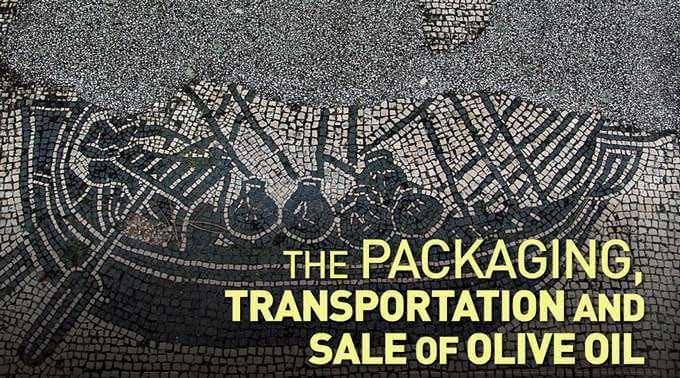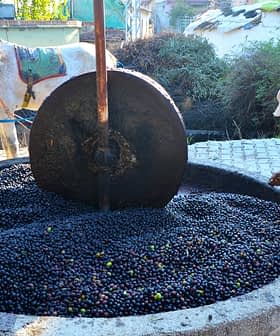The main hub of oil production in ancient Baetica was centred in the Valle Medio del Guadalquivir. Here there was a predominance of the potter centres in which large and heavy oil amphorae were manufactured to transport oil. The very same that later were piled up on the inside of the ships crossing the wide sea to trade with this product. Of all of them, the Dressel 20 lasted for the central centuries of the Roman Empire.
“In the midst of a sea of olive trees, spattered with silver, white and pale indigo, the activity in the potter’s workshop was frenetic. It consisted of a few modest, but robust, buildings with walls made of thousands of amphora fragments and covered with tiles that were also manufactured on site. Perched on a small hillock close to the banks of the Betis, lit by sunlight and safe from possible floods, very close to Carbula… A few hundred metres inland, a large group of slaves –almost unrecognisable in their involuntary camouflage caused by the thick layer of mud that covered their bodies – pulled the clay from an uneven pit that others then went on to knead laboriously and ultimately leave it in a decantation bag for a number of days … This clay was used by the potters to mould the large amphorae with narrow mouths and fat bellies which were dried upside-down and in copious amounts on the great esplanade located beside the southern façade of the complex; the seals of the potter brand were clearly visible on the upper part of the belly or the handles… Lastly, a battery of eight kilns made entirely of adobe and clay and set in a line parallel to the river, were constantly smoking, using fire to cook the ceramic recipients until they were strong and resistant enough to survive the long crossing the majority of them were destined for, having become practically indestructible …”
This extract from the work, El Árbol del Pan (Plurabelle. Cordoba, 1994, 53 – 54), written by the undersigned author of this article, very clearly details how and where our prized liquid gold was stored in the past.
The text certainly makes how the oil market was organised very clear. The main Baetica oil production hub was located in the Valle Medio del Guadalquivir, where there was an abundance of oil amphora production centres which, occasionally, coincided with the agricultural settlements as well. However, other times they sought the closeness of the rivers Baetis and Singilis, with a view to avoiding the unnecessary transportation of heavy and voluminous recipients. This may well have been a different business that did not lie in the hands of those responsible for making the oil. Thus, what was moved was the oil itself, in skin bottles that were later poured into the amphorae just before embarking.
Potter centres
These pottery centres, which identified the amphorae with the seal of the potter’s workshop on the handle (a seal that usually included an abbreviation of the owner, producer or officina’s full name ‑tria nomina-), were abundant in the countryside of Cordoba, Almodóvar del Río, Posadas, Peñaflor, Écija… This is why it is common to see on the land, in the clefts of the river, those same ovens in an excellent state of preservation integrated into far larger complexes (some of them up to 20 hectares, such as that of La Catria, in Lora del Río, Seville). These complexes tended to have other buildings as well, such as workplaces, living areas, storehouses, etc., and often their own necropolis.
This is the main reason why large amphora fragments (opus testaceum) are so common in the houses throughout all of these areas. Strangely enough, these fragments were also used as construction materials for domestic and manufacturing structures, including the ovens.
Potters and potter’s workshops
Nowadays, based on an analysis of the seals, we know that there were at least 100 figlinae (workshops) in the area and that at least 250 potters were at work; this, without taking into account those that left no trace of their work, which has simply been lost or remains to be discovered.
Archaeological digs in the area, contrasted against the study of amphorae and Tituli picti of the Testaccio, provide us with an enormous volume of information that allows us to get to know quite a lot of detail. Thus, for example, we know that the potter’s workshop located in the Cortijo del Temple, close to Palma del Río (conventus Cordubensis) produced a vast amount of amphorae in the Flavean-Trajanean period (last years of the 1st century AD) for a well-known figure of the period, Caius Marius Silvanus, which also appears on the seals of the Testaccio amphorae with the nomen Marium.
The pampered daughter of the Empire: the Dressel 20
These potters, who laboured non-stop all year round, logically experienced various political , economic or social evolution turnarounds in the course of their existence, with leadership changing hands more than once. In some cases, they were even confiscated by the great Beatica estates that produced oil in tense moments of ideological readjustment.
It was there that a specific amphora type was manufactured, known in archaeology jargon as Dressel 20. Thanks to its perfect functionality, this vessel lasted throughout the central centuries of the Empire, with small variations that ended up generating other categories: Tejarillo I and Dressel 23.
It is quite a large recipient, with a globular shape that weighs 30 kilos and could contain 70 litres of oil. It was manufactured in different stages: first the belly, then the mouth and finally the base (closing the orifice that had been left open to facilitate drying), and finally the handles. As stoppers, they could use very simple discs of clay designed specially for this purpose (occasionally, a simple fragment of cut out ceramic), bits of cork or mini amphorae containing a sample of the content, thus making it possible to verify its quality without having to open the recipient, that was usually sealed.
Relics found
We can contemplate Dressel 20 amphorae, the majority completely intact, in many of our museums. Thousands of them also lie at the bottom of the sea, in wrecks that never reached their port. They stand out for their enormous bellies and surprising ergonomics, as they allowed for the product to be sealed perfectly, were easy to transport and, very particularly, provided a functional piling system in the hold of the ships responsible for transporting them throughout the Empire.
These are ships we know very well, both because of the wrecks found, and the relief and mosaic illustrations of them which abound, for instance, in the port of Ostia, where the majority of them put in. They tended to be half draft sail boats, and could hold up to 10,000 wine or oil amphorae, set out using a simple piling system that allowed for the bottoms of some to be wedged between the mouths of those in the lower row, in such a way that between 150 and 200 tonnes could be transported.
Desiderio Vaquerizo Gil










